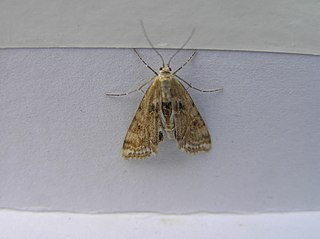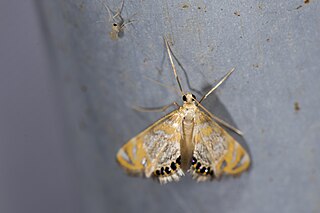
The Crambidae are the grass moth family of lepidopterans. They are variable in appearance, the nominal subfamily Crambinae taking up closely folded postures on grass stems where they are inconspicuous, while other subfamilies include brightly coloured and patterned insects which rest in wing-spread attitudes.

The Pyralidae, commonly called pyralid moths, snout moths or grass moths, are a family of Lepidoptera in the ditrysian superfamily Pyraloidea. In many classifications, the grass moths (Crambidae) are included in the Pyralidae as a subfamily, making the combined group one of the largest families in the Lepidoptera. The latest review by Eugene G. Munroe and Maria Alma Solis, in Kristensen (1999) retains the Crambidae as a full family of Pyraloidea.

The Pyraloidea are a moth superfamily containing about 16,000 described species worldwide, and probably at least as many more remain to be described. They are generally fairly small moths, and as such, they have been traditionally associated with the paraphyletic Microlepidoptera.

Cataclysta lemnata, the small china-mark, is a moth species of the family Crambidae. It is found in Europe, Morocco and Iran.

Nymphicula is a genus of moths of the family Crambidae.

Paracymoriza is a genus of moths of the family Crambidae.

Pyrausta phoenicealis, the perilla leaf moth, is a moth of the family Crambidae described by Jacob Hübner in 1818. It is found worldwide, including the Americas, Africa, Australia and Asia.
Glaphyriinae is a subfamily of the lepidopteran family Crambidae. It was described by William Trowbridge Merrifield Forbes in 1923

Scopariinae is a subfamily of the lepidopteran family Crambidae. The subfamily was described by Achille Guenée in 1854.

Eoophyla capensis is a moth in the family Crambidae. It was described by George Hampson in 1906. It is found in Angola, Cameroon, Ethiopia, Kenya, Liberia, Malawi, Mozambique, Namibia, Nigeria, South Africa, Tanzania, Uganda, Zambia and Zimbabwe.
Eupoca sanctalis is a moth in the family Crambidae. It is found from central Costa Rica south to northern Colombia.
Eupoca chicalis is a moth in the family Crambidae. It was described by William Schaus in 1920. It is found from Guatemala south-east to French Guiana.
Lipocosma nigripictalis is a moth in the family Crambidae. It is found from southern Mexico south to Brazil.
Lipocosma calla is a moth in the family Crambidae. It was described by William James Kaye in 1901. It is found from southern Mexico south through Central America to northern South America.
Lipocosma furvalis is a moth in the family Crambidae. It was described by George Hampson in 1912. It is found from Mexico south to Costa Rica and the Lesser Antilles.
Parambia gnomosynalis is a moth in the family Crambidae. It was described by Harrison Gray Dyar Jr. in 1914. It is found from Guatemala south through Central America to northern South America.
Glaphyria citronalis is a moth in the family Crambidae. It was described by Herbert Druce in 1899. It is found from south-eastern Mexico south to Central America and Brazil.
Glaphyria decisa is a moth in the family Crambidae. It was described by Francis Walker in 1866. It is found from Guatemala to south-eastern Paraguay. It is also found in Cuba.
Glaphyria rufescens is a moth in the family Crambidae. It was described by George Hampson in 1912. It is found from Costa Rica south to Panama.
Afroscoparia contemptalis is a moth in the family Crambidae. It was described by Francis Walker in 1866. It is found in South Africa, where it is found in the south-western part of the Western Cape Province.







